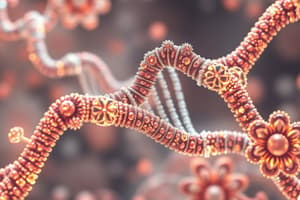Podcast
Questions and Answers
PCR stands for
PCR stands for
polymerase chain reaction
PCR was invented by
PCR was invented by
Kary Mullis
The primers used in PCR are about 15 to 24 nucleotides in length and are called
The primers used in PCR are about 15 to 24 nucleotides in length and are called
oligonucleotides
The three steps involved in each cycle of PCR are: Denaturation, Primer Annealing, and
The three steps involved in each cycle of PCR are: Denaturation, Primer Annealing, and
The starting material of a PCR experiment can be a complex mixture of
The starting material of a PCR experiment can be a complex mixture of
Flashcards are hidden until you start studying
Study Notes
PCR (Polymerase Chain Reaction)
- PCR stands for Polymerase Chain Reaction
- PCR was invented by Kary Mullis
Primer Characteristics
- Primers used in PCR are about 15 to 24 nucleotides in length
- These primers are called oligonucleotides
PCR Cycle Steps
- The three steps involved in each cycle of PCR are:
- Denaturation
- Primer Annealing
- Extension
Studying That Suits You
Use AI to generate personalized quizzes and flashcards to suit your learning preferences.




